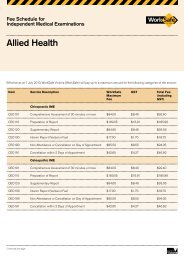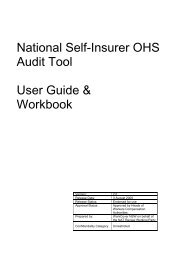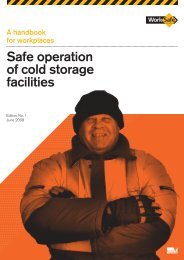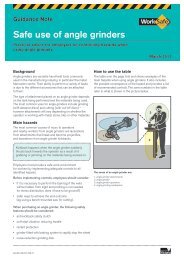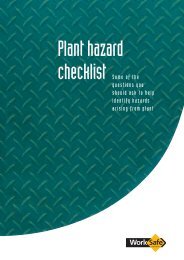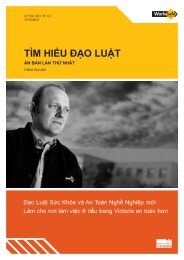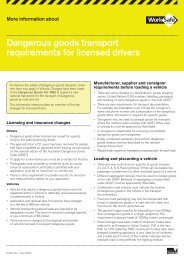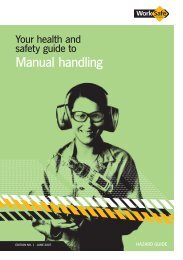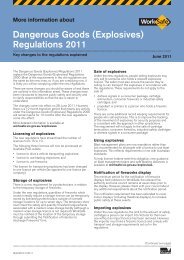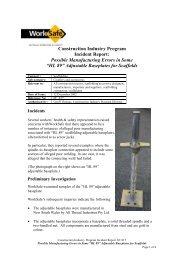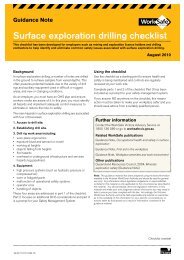Dairy Safety: A Practical Guide (PDF 1708kb) - WorkSafe Victoria
Dairy Safety: A Practical Guide (PDF 1708kb) - WorkSafe Victoria
Dairy Safety: A Practical Guide (PDF 1708kb) - WorkSafe Victoria
- No tags were found...
Create successful ePaper yourself
Turn your PDF publications into a flip-book with our unique Google optimized e-Paper software.
ContentsIntroduction ..............................................11 <strong>Safety</strong> Basics ....................................... 22 Safe Design ......................................... 53 Confined Spaces .................................... 8Potential Confined Spaces – Milk Vats .......................9Potential Confined Spaces – Grain Silos ....................104 Effluent ............................................ 115 Chemicals ......................................... 136 Zoonoses .......................................... 177 Traffic .............................................. 198 Environment – Noise ............................... 209 Environment – Extreme Temperatures ............... 2210 Environment – Slips and Trips ....................... 2411 Children ........................................... 2612 Manual Handling ................................... 28Manual Handling – Lifting and Carrying .................... 29Manual Handling – Milking ................................. 30Manual Handling – Other Hazards ......................... 3113 Electricity .......................................... 3214 Working at Heights ................................. 3415 Emergency Response .............................. 3616 Asbestos .......................................... 3817 Cooling Towers ..................................... 3918 Acknowledgements and Further Information ......... 40<strong>WorkSafe</strong> <strong>Victoria</strong> is a division of the <strong>Victoria</strong>n WorkCover Authority.The information presented in this guidance material is intended for general use only.It should not be viewed as a definitive guide to the law, and should be read in conjunction with the Occupational Health and <strong>Safety</strong> Act 2004.Whilst every effort has been made to ensure the accuracy and completeness of this publication, the advice contained herein may not apply inevery circumstance. Accordingly, the <strong>Victoria</strong>n WorkCover Authority cannot be held responsible, and extends no warranties as to:• the suitability of the information for any particular purpose;• actions taken by third parties as a result of information contained in this publication.
1safety basicsThis guide was produced with the dairy industry in response to requests fromfarmers for straightforward information to help them make working in the dairy safer.It provides practical safety solutions to specific hazards, and information on howto control or eliminate safety hazards.Making your farm safe requires planning, and farmers are encouraged to usethis guide in the preparation of their own safety action plans that include detailedassessments of their specific safety hazards and actions to control or eliminatethose hazards.Three Steps to a Safer <strong>Dairy</strong><strong>Dairy</strong> farming can be a hazardous occupation.Farmers have large and sometimes unpredictable animals to control. They useheavy equipment and must deal with issues such as hazardous substances,zoonotic diseases, confined spaces, and working at heights and manual handling.Technological advances have reduced some hazards but created others.For example, rotary dairies have created very efficient milking but have alsointroduced crushing and trapping points.As with any safety plan, making your dairy safer involves identifying hazardsand the relative risk involved with each hazard so that control measures canbe prioritised. Not all farms are the same and even though there are similaritiesin work practices and risks, you need to identify, assess and put in place yourown risk control solutions to achieve the best safety outcome for your farm.Many hazards can be reduced through regular housekeeping. Maintaining a cleanand tidy dairy as part of everyday operations will result in a safer workplace.While specific safety requirements for each farm will vary, there are three simplesteps to achieving a safer workplace:• Find the hazards• Assess the risks• Fix the hazards.2 WORKSAFE VICTORIA / DAIRY SAFETY_A PRACTICAL GUIDE
safety basicsPurchasing a machine that has had all of its hazards eliminated through safedesign means that you have purchased something that not only does the jobyou want it to do but does the job safely.For example, milk vats designed so they can be cleaned and serviced externallyeliminates the potential risks associated with confined spaces.Substitute the HazardIf the hazard cannot be eliminated, it may be able to be substituted with one that isless harmful, e.g. install a quieter vacuum pump or use a less hazardous chemical.Engineering ControlsIf the hazard cannot be substituted or eliminated, engineering controls canbe effective ways to reduce risks of hazards occurring. These controls includebarriers to isolate people or animals from the hazard, such as a guard coveron a feed auger, a ‘safety switch’ on an electrical system, or the constructionof a chemical storage shed.Administrative Controls/Work PracticesIf engineering controls cannot be applied, a mix of administrative controls shouldbe considered.A variety of information sources should be considered when developing safetyaction plans and procedures for use in the dairy. The information may be in theform of this guide, a training and induction program, a training video or safetysigns on the dairy wall and the farm fence.Personal Protective Equipment (PPE)This is always the last control measure to be considered because there is stilla potential risk of the individual being injured; the effectiveness relies on theindividual wearing and using PPE properly. PPE is effective for personal controlbut provides no protection for other workers.If you have controlled the risk by some other method you may not need to wearPPE such as faceshields/dust masks, earmuffs or gloves. PPE is often usedin conjunction with other risk controls measures.WellbeingOver recent years there has been a growing awareness of the real impactof psychological hazards within work places.Specifically, these are hazards of stress, fatigue, bullying and other tensions fromsocial interaction with others. Farmers struggle through many issues – drought,market downturns, fire and continually increasing costs. The economic difficultiesare being reflected in occupational safety choices. During difficult times, it istempting to take short cuts at work and not invest sufficiently in safety equipment,training or safe work practices. It is important that the reality of stress, bullyingand fatigue is recognised by dairy farmers and control measures for psychologicalhazards are considered in safety action plans.Cow BehaviourCows can be unpredictable so an understanding of cow behaviour is importantto maintaining a safe dairy.Good stock handling skills and the gentle treatment of heifers and cows willhelp to reduce kickers and result in a more relaxed and productive herd.Cows that are mistreated or are bitten by dogs are more likely to kick or lashout at farmers. Farm managers should provide training on stock handling skillsto employees. Supervision of employees may be necessary to ensure thatmistreatment does not occur.Training should include how to approach cows with knowledge of the cows’flight zone and point of balance. Bulls should never be trusted. ‘Dangerous’bulls should not be moved on foot or handled on your own.4 WORKSAFE VICTORIA / DAIRY SAFETY_A PRACTICAL GUIDE
2safe designThe most effective way to develop a safe dairy is to design it that way from thevery start. Dairies need to be safe places for farmers, workers, families and cows.<strong>Safety</strong> benefits can be achieved when the needs of cows and people areintegrated into the dairy design.Existing dairies can have many safety features incorporated into refits, milking shedexpansions and dairy upgrades. The safe design suggestions below are only somethat are available. Others can be found throughout this guide.risk factors• Exposed platform rollers on rotary platforms.• All slippery surfaces including holding yards, walkways, herringbone pitsand cups-on and cups-off positions in rotary dairies.• Projections at head height such as receivers, interceptors, pipes and rails.• Unguarded herringbone rapid exit mechanisms.• Moving rotary platforms passing fixed rails can potentially trap or crusha person.• Carrying out cattle husbandry, AI and pregnancy testing on rotary platforms.• Cows going down and/or entering the pit.• Cracked or leaking pipe joints on milk lines.• Contact with unguarded equipment.• Kicking cows.• Distressed cows.• Extremely hot water.• Poorly designed cow entries and exits that have turns, ramps or steps,or that are too steep.• Inadequate drainage.WORKSAFE VICTORIA / DAIRY SAFETY_A PRACTICAL GUIDE5
safe designrisk controlsA strategically located ‘escape’.A ‘banana rail’ reduces the risk ofentrapment. Emergency stoplanyard/cord is located above thetop rail.• Provide a skirt around the platform or guards on the rotary dairy platform rollers.• Use rubber non-slip matting or concrete grooving on surfaces to increasetraction.• Remove head-high obstacles and hazards, especially pipes and rails.• Rapid exits in herringbone dairies should be guarded to prevent humanentrapment in both the shed and yards.• Fit a ‘banana’ rail between the backing and kick rails of rotary platforms.• Fit purpose built artificial insemination/pregnancy testing platforms with stepsand rails.• Construct a separate AI/pregnancy test race alongside the dairy.• Emergency stop mushroom buttons should be installed.• A lanyard (cord) operated emergency stop system is recommended insteadof the forward/stop reverse lanyard. Do not disconnect these lanyards forany reason.• Quick release systems should be in place to allow cows to be releasedif they go down in the bail.• Installation of kick rails.• Replace the hot water pipe jointing to ensure there are no leaks orweaknesses. Ensure the joins meet the Australian Milking MachineTrades Association guidelines.• Position extremely hot water taps used for cleaning in a place not easilyreached by children.• Place lids on drums in cleaning systems.• Extend pipes and hoses deep into the drums to minimise splashingof extremely hot water.• Label water pipes and taps with safety signs that indicate:– Extremely hot water;– Water that is not suitable for drinking; and– Wastewater.• Installation of suitably sized personnel escapes or refuges in yards.• Cow entries in a straight line.• Design a cow entry that has a slope of less than 6% and that slopesup to the dairy.• Allow at least 2.5 metres width in the exit lanes.• Install dairy and yard drainage that will meet current Environment ProtectionAuthority (EPA) water management standards, and expected volume of runoff.This herringbone dairy has beenrefitted with new milk lines andupgraded with Automatic CupRemovers.6 WORKSAFE VICTORIA / DAIRY SAFETY_A PRACTICAL GUIDE
safe designMachine GuardingIn the dairy the following machinery parts can present serious risk of injuryif not guarded:Rapid exit guards reducing the riskof entrapment.• Belts and pulleys as found on vacuum and milk pumps and auger motors;• Flywheels and gear wheels on generators;• Shafts and spindles on vacuum pumps and milk pumps and also on thetractor Power Take Off (PTO) drive when the tractor is the alternativesource of power;• Chain and sprocket gears as on some backing gates and grain crushers;The hazardous parts of these machines can be described as:• ‘Drawing in’ points or ‘nip points’. These can occur where a belt makescontact with a pulley. These points can grab at fingers and draw in theoperator causing serious injury;• Shear points. Shear points are items or parts of a machine that move againsteach other and can cut by pinching. Often this hazard occurs on machinessuch as exposed flights on augers;• Impact and crushing areas. These are similar to shear points but theydon’t cut. These points will crush a limb or person such as rotary platformrollers, between fixed rails and the moving stalls on a rotary, hydraulicor pneumatic gates as found on cow entrance and exits on all dairy types;• Entanglement areas. These are areas that can catch clothing and hair,such as exposed rotating shafts on pumps.Further information on guarding can be obtained from <strong>WorkSafe</strong> andStandards Australia.The skirt around the base of thisrotary dairy is an effective guard forrollers and nip points.WORKSAFE VICTORIA / DAIRY SAFETY_A PRACTICAL GUIDE7
3Confined SpacesThere are several areas on dairy farms that may be classified as confined spacesincluding milk vats, silos and water tanks. In each of these cases there are waysfor eliminating the confined space hazards through safe design. Removing theneed or possibility of ever entering these spaces eliminates the risk.It is vital that you determine whether any of your work areas in and around thedairy are confined spaces. The definition of ‘confined space’ in the Confined SpacesRegulations should be used in order to determine whether something is, or is not,a confined space.Silos with steep cones that ensurecomplete emptying and bottominspection.Confined spaces are defined in the Regulations as a space in a vat, tank, pit,pipe, duct, flue, oven, chimney, silo, container, reaction vessel, receptacle,underground sewer, shaft, well, trench, tunnel or other similar enclosed orpartially enclosed structure, if the space meets certain conditions.A confined space is determined by the hazards associated with a set of definedcircumstances (restricted entry or exit, hazardous atmospheres or risk ofengulfment) and not just work performed in a physically restrictive location.The presence of physical or chemical agents acting alone or in combination maybe exacerbated in a confined space.Source: Code of Practice for Confined Spaces 1997.Each silo should have appropriatesignage that meets any relevantAustralian Standard.Risk Assessment CriteriaIn assessing your dairy for any confined spaces (including grain silos andmilk vats) ask the following questions:1. Is the space likely to be entered by any person?2. Does the space have a limited or restricted entry or exit?3. Will the space have a normal atmospheric pressure when someone is inside?4. Is the space likely to contain:• An atmosphere that has a harmful level of contaminant?Or• An atmosphere that does not have a safe oxygen level?Or• Any non-liquid substance that could engulf someone?If you answered YES to ALL of the four questions above then your grain siloor milk vat is a confined space and the Confined Spaces Regulations apply.You need to keep in mind that if you answered NO to any of the four questionsabove, it does not necessarily mean that the space is safe. For example,the use of an LPG forklift in a coolroom is not a confined space situation butit can be dangerous because of carbon monoxide fumes.8 WORKSAFE VICTORIA / DAIRY SAFETY_A PRACTICAL GUIDE
Confined SpacesPotential Confined Spaces – Milk VatsUnder certain conditions milk vats and milk silos could be regarded as ‘confinedspaces’ and come under the Confined Space Regulations. This may be the casewhere there is a likelihood that refrigerant may leak into the vat or a chemical isused (e.g. cleaning) inside the vat that may be harmful to health.When upgrading milk vats purchaseone that does not require entry forcleaning.Refrigerant or chemical vapours in a vat or milk silo may displace oxygen, leadingto the high risk of suffocation. Structured cleaning, venting and other routinelyimplemented procedures can reduce the risks to personnel working in these areas.However there are associated hazards outside the vat that should be consideredsuch as accessing the top of the vat from a height of more than 2 metres.(Refer page 34 – Working at Heights.)risk factors• Low oxygen levels inside the milk vat due to oxygen displacement bychemicals and refrigerants.• Exposure to chemicals introduced into the vat.• Injury from agitators within the vat.• Heat stress generated from working inside the milk vat.• Rescuing someone from a milk vat.Modern closed cleaning systemsreduce the need to enter the vatfor cleaning and minimise thehandling of chemicals.A bottom access hatch on a milk vat.risk controls• Assess the risk of accessing the vat from a height of over 2 metres.(Refer to page 34 for more information on working at heights.)• Install a vat that does not require entry at all.• Clean vats from outside with pressure washer and/or detergents rather thanentering the vat.• Restrict access by using a suitable lock-out system.• Indicate with signage that there is ‘Authorised Access Only’.If you have to enter the milk vat:• After the wash cycle a cold rinse should be put through the vat and ventilationcarried out prior to entry.• Turn off and isolate all power to the vat before entry. A mechanism mustbe in place to make sure that the agitator is electrically isolated prior tomaintenance or cleaning.• You may need to use mechanical ventilation to vent the space when youare inside.• Use any available internal and fixed ladder access.• Clean vats with inert chemicals only.• Ensure the access hatch remains open while you are inside to provideventilation.• To avoid accidental closure the access hatch may need to be fixed openwhen in use.If you are dealing with a confined space, you need to have an entry permitsystem and warning signs to prevent unauthorised access.Always have a responsible second person on site with you when you workinside a vat or milk silo. This needs to be a person who can see what you aredoing and someone who is capable of implementing emergency procedures ifrequired in case of collapse or injury within the vat. (Refer Emergence Responsepage 36.)More information on working in confined spaces is available from <strong>WorkSafe</strong>.(Refer rear cover.)WORKSAFE VICTORIA / DAIRY SAFETY_A PRACTICAL GUIDE9
Confined SpacesSilos should have a bottom accesshatch.Potential Confined Spaces – Grain SilosSilos may also be potential confined spaces and present a range of hazards.Most silos continue to have an elevated access point which is reached by fixedor removable ladders. This complicates the confined space risks and includes thereal risk of falling from heights.<strong>Victoria</strong>n Prevention of Falls Regulations requires farmers to address falling riskswhen working above 2 metres. (Refer to page 34.)Grain blockages can occur and the temptation is to enter the silo to loosenthe blockage. Blockages should be removed or loosened from outside the silo,eliminating the risk of being trapped in the silo, or being injured through cominginto contact with the grain auger.risk factors• Exposure to dusts and chemicals.• Being engulfed in grain and suffocating.• Loosening grain build up from inside the silo.• Low oxygen levels inside the silo due to unusual circumstances.• Unguarded auger flights.risk controlsAdding canola oil or other vegetableoil to grain will reduce dust.Steep coned silos empty completelyand eliminate the need to enterthem to remove grain.• Use steep-coned silos.• Attempt all jobs from outside the silo to avoid entering a silo.• Ensure silos are sealed to prevent moisture getting into the silo.• Clear the grain buildup from the outside through a bottom access.• Add vegetable oils to grain to reduce dust in the dairy.• Install a mesh guard over exposed auger flights in and out of silo.• Install signage that indicates ‘authorised entry only’.If you have to enter the silo:• Ventilate silos before entering by opening lids and, possibly, the bottom access.• Switch off augers before entering a silo and make sure that no-one canstart filling or emptying the silo while you are inside (install isolation orlock-out switches).• Install isolation switches to the feeding system to allow the plant to be lockedout when conducting silo maintenance (an isolation switch can preventanother person inadvertently switching on the feeding system when someoneelse is working on it or inside the silo).• Use bottom access only.• Make sure that sparks and flames are kept away from grain storage areasto avoid a potential dust explosion.• Avoid or reduce exposure to chemical additives such as phosphine.• When applying chemicals such as phosphine to grain refer to the silomanufacturer’s guidelines and chemical MSDS.• Put in place and practice emergency rescue procedures.• If there is a person who may be in difficulty, do not follow them in unlessyou are sure that the area has enough oxygen and sufficient access.If you are dealing with a confined space, you need to have an entry permitsystem and warning signs to prevent unauthorised access.Always have a responsible second person on site with you when you workinside a silo. This needs to be a person who can see what you are doing andsomeone who is capable of implementing emergency procedures if required incase of collapse or injury within the silo. (Refer Emergence Response page 36.)More information on working in confined spaces is available from <strong>WorkSafe</strong>.(Refer rear cover.)10 WORKSAFE VICTORIA / DAIRY SAFETY_A PRACTICAL GUIDE
4EFFLUENTIneffectively managed waste and effluent systems can affect the health of allpeople in the dairy, so it is important to design and implement an effective waste/effluent system, including the management of dairy effluent ponds.Poorly managed effluent ponds, dairy sheds and yards can help disease tospread and can lead to young children being exposed to the risk of drowning.Effluent ponds can allow a build-up of a crust and subsequent weed growthover the surface of the effluent pond. The crust may look like solid groundbut it will not stand the weight of a person or animal and they may fall throughthe crust and into the effluent pond. Ineffectively drained areas can increasethe risk of slips and falls for livestock and workers. Inadequate wastemanagement also increases the health risks associated with flies and insects.Fenced off effluent pond in paddock near the dairy.WORKSAFE VICTORIA / DAIRY SAFETY_A PRACTICAL GUIDE11
effluentrisk factors• Children and cows falling into ponds.• Increased disease risk from flies and mosquitoes.• Poor environmental hygiene.• High pressure hoses and high volume flood washing.• Increased risk of slips, trips and falls.• Exposed moving parts of effluent pumps.Fenced off solids trap by the dairy.A hydrant hose will eliminate thedragging of hoses however careshould be taken to ensure childrenare not around when they are in use.risk controls• Provide adequate supervision of children visiting the dairy.• Ensure that solids traps are fenced off or covered to prevent children fromfalling in. In some cases standard swimming pool fencing could be used.• Locate effluent ponds as far away from the dairy as practical.• Avoid unstable steep batters.• Signage warning of the risks of drowning.• Make sure that children and others are not present when flood orhydrant washing.• Separate tracks from effluent areas and dams.• Empty regularly and ensure the trap drains properly.• Ensure exposed moving parts of effluent pumps are guarded and that accessby children is prevented.• Minimise the amount of water that is used to wash down areas, and regularlypump out effluent ponds as required in late spring and late autumn.• Secure high pressure hoses when turning on and store them out of the waywhen not in use.• Remove sharp edges/clamps from hand-held hoses.• Ensure appropriate clothing and protective equipment is provided and wornby workers, such as gloves, aprons, rubber boots, goggles and other skinprotection when coming in contact with animal wastes.• Maintain or replace all personal protective equipment regularly.12 WORKSAFE VICTORIA / DAIRY SAFETY_A PRACTICAL GUIDE
5ChemicalsChemicals are used widely in dairies. These include cleaning chemicals, detergents(acid and alkaline), formalin, teat sprays (iodine), antibiotics, drenches (oral andbackline), lice treatments and other veterinary medicines such as prostaglandins.Hazardous Substances are chemicals that have a greater risk to a person’s healththan other chemicals. The Hazardous Substance Regulations impose a range ofduties including:• Setting up a hazardous substances register (i.e. list of products and copyof MSDS);• Assessing the risk to health;• Controlling or minimising the risk by putting safety measures in place.Restricted chemicals can only be used by suitably qualified people and prescribedrecords must be maintained for their use, e.g. phosphine as a grain fumigant.Dangerous Goods are classified on the basis of having immediate effects topeople, the environment or to property, such as fire, explosion, poisoning orcorrosion, e.g. acids and alkalines are classified as corrosives.Many chemicals are classified as both Hazardous Substances and DangerousGoods, e.g. formalin. In such cases, both the Hazardous Substances and theDangerous Goods Regulations apply.Classifications of individual chemicals can be found in the Material <strong>Safety</strong> DataSheet (MSDS) that manufacturers and suppliers are required to provide and areoften available on manufacturers’ websites. MSDSs provide critical informationabout a chemical including:• The physical properties of the chemical and the names of the ingredients;• Hazards or health effects associated with the chemical;• Precautions to be taken;• Guidance for transport, use, storage and disposal;• Withholding periods;• First aid information; and• Personal protective equipment to be used.Chemical use can be dangerous at all times, but particularly when you are exposedto a chemical concentrate. Chemicals can be absorbed into the body through:• Skin contact;• Breathing fumes – when applying, cleaning, decanting or mixing; and• Ingesting the substance – by accident or through poor hygiene.Chemicals are most commonly absorbed through the skin especially around thehead, neck, arms, hands and groin, due to splashing or spillage when decantingconcentrates or using the chemical.WORKSAFE VICTORIA / DAIRY SAFETY_A PRACTICAL GUIDE13
ChemicalsChemicals can build up in the body over a period of time or the effects ofpoisoning can occur very quickly. Some farm chemicals are also known to causecancer, while others can cause nervous or reproductive disorders, damage tointernal organs and skin problems. Some chemicals are also flammable, whichrepresents an added risk of explosion and fire.Whenever chemicals are used, know what you are using, read the labels,read and understand the MSDS for the chemical involved and follow the safetyprecautions prescribed.risk factorsTeat Spray being applied with along nozzle reducing the risk ofinhaling aerosols and being kicked.• Burns and other injuries from using dairy chemicals such as acids, alkalines(caustics), iodine teat sprays, formalin, antibiotics, vaccines, drenches, licetreatments and veterinary chemicals including hormones.• Exposure to herbicides and insecticides.• Exposure to farm chemicals while decanting, adding to feed, or spraying.• Needle stick injuries from vaccinations and administering antibiotics.risk controlsElimination or Substitution Controls• Undertake a review of all farm chemicals to determine whether workprocesses require the use of chemicals.• Remove all unwanted, out-of-date and banned chemicals from the dairyand dispose of in line with regulations and according to the MSDS.• Determine whether there are other chemicals available that pose less riskto people. For instance, alternatives to phosphine for controlling insect pestsin grain.• Develop a plan for dealing with chemical emergencies or spillage that includesfirst aid and emergency contacts.A power washer can be used as analternative to chemicals to removealgae in the dairy.14 WORKSAFE VICTORIA / DAIRY SAFETY_A PRACTICAL GUIDE
Chemicalsrisk controlsSecure and locked chemical storagein the dairy with concrete floor andbunding to contain spills.<strong>Safety</strong> signage indicates thatcorrosive acid and alkaline dairydetergents (Dangerous Goods) arestored or are in use in this room.Engineering and Isolation Controls• Install a closed chemical delivery system that removes the need for directcontact with chemicals.• Chemical storage should provide spill containment, be well ventilatedand lockable.• Chemicals in use should be isolated behind a child-proof barricade.• All chemicals not in use should be stored and locked away in a purposebuilt chemical locker or shed. Do not store chemicals in a work area suchas the vat room.• Veterinary chemicals requiring refrigeration should be kept in a separaterefrigerator that is not used for food and drinks such as a small lockablebar-type fridge.• Have chemicals delivered to the farm whenever possible.• Consider using pumps, siphons or gravity taps to extract drum contents.• Use containers that have a pump action, rather than pouring from drumsto prevent spills and reduce exposure during the decanting of chemicals.• Mix chemicals in a ventilated area, on a non-porous surface that can bereadily cleaned, and with close access to clean reticulated water for cleaningor first aid.The area should be:– Well-lit;– Level;– Uncluttered; and– Away from children, pets and others.• Chemical spills should be contained, cleaned up and disposed of accordingto the label and MSDS.• Dispose of needles in chemical sharps containers. (Discuss the properdisposal procedure with your Vet.)• Chemicals in use in the dairy should be inaccessible to children and others.• Do not store or mix acids and alkalis together and segregate them fromother chemicals.• Provide an emergency shower and eyewash at the chemical storage area.• Use coarse spray techniques to reduce exposure to spray mist.Caustic cleaners in a locked andbunded enclosure.WORKSAFE VICTORIA / DAIRY SAFETY_A PRACTICAL GUIDE15
Chemicalsrisk controlsEmergency shower and eyewashoutside a chemical store.Administrative Controls• Develop a formal chemical management plan.• An MSDS must be obtained, be available for every chemical used and beno older than 5 years.• Make sure users of restricted chemicals are suitably qualified.• Provide adequate training to all users of chemicals.• Follow stated withholding periods for chemicals used for milk and meat.• Keep a chemical register.• Make sure that chemicals are loaded, transported and unloaded safelyand securely – not in the passenger area or boot of a passenger vehicle.• Make sure all chemical containers are labelled.• Return chemicals including stock sprays to the locked store after use.• Dispose of chemical containers according to the MSDS.• Use drum recycling programs.• Provide training on safe injecting procedures.• Make sure workplace rules are in place for the use of chemicals and thatall workers follow these rules.• Ensure all fittings are secure before beginning the cleaning process.Personal Protective Equipment• Use the appropriate personal protective equipment for the chemicals in use(check MSDS and label).• Use Personal Protective Equipment (PPE) when decanting, mixing or usingchemicals, according to the label and MSDS.• Employers must supply and maintain PPE to their workers, which is suitablefor the job and in good and clean condition.• Employees have a responsibility to wear PPE and maintain it in good condition.• PPE should be used to complement other protective solutions as mentionedin the Introduction to this guide.For all emergencies ring 000Poisons Information Centre 13 11 2616 WORKSAFE VICTORIA / DAIRY SAFETY_A PRACTICAL GUIDE
6ZoonosesZoonoses are serious diseases that are transferable to humans from animals causingmild to life-threatening human health problems. People working with livestock,including those working in the dairy, may be exposed to these infections.The effects of these diseases can vary in seriousness from severe flu-like symptoms(for example Leptospirosis, Q Fever), gastroenteritis (e.g. Salmonellosis), throughto death (such as from hydatid disease), or the death of the developing human foetusduring pregnancy (e.g. toxoplasmosis, a disease principally contracted from cats).Splashguard in a herringbone dairy.WORKSAFE VICTORIA / DAIRY SAFETY_A PRACTICAL GUIDE17
Zoonosesrisk factors• Contact with blood, saliva, faeces and urine (e.g. Leptospirosis and Q Fever).• Eating or drinking infected animal products (e.g. Salmonellosis).• Inhalation of dust, aerosols or spores from infected animals (e.g. Anthrax).• Handling infected animals (e.g. Ringworm).risk controls• Vaccination of livestock for leptospirosis.• Vaccination of people for Q fever.• Consult with your veterinary practitioner in relation to vaccinations.• Make sure that animal wastes do not come into contact with human foodand drinking water.• Provide readily accessible hand washing facilities for all personnel.• Mark taps clearly that are not suitable for drinking water.• Reduce the amount of dust in the workplace, as dust can carry disease.• Design the dairy shed so that it can be easily cleaned, has good airflow andlots of natural light.• Follow good animal husbandry and good hygiene practices in all dairy operations.• Wash your hands before eating, drinking or smoking.• Avoid contact with animal wastes and especially animal carcasses, animalexcretions and offal.• Make sure that cuts, abrasions and animal bites are treated and disinfectedimmediately.• Advise your local doctor of your occupation to assist in diagnosis.• Try to avoid eating raw meats or non-pasteurised dairy products.• Direct airborne contaminants and wastes away from the work area.For example install splashguards to protect workers from urine splashes.• As part of induction, provide information on zoonoses and the correctprocedures for vaccination.• Provide appropriate clothing and protective equipment for workers, such asaprons, rubber boots, gloves, goggles and other skin protection and make surethat it is worn when coming in contact with animal by-products and wastes.• Maintain your personal protective equipment in good condition and replaceas required.• Consider using needle stick-proof gloves when vaccinating.• Remove dead animals.18 WORKSAFE VICTORIA / DAIRY SAFETY_A PRACTICAL GUIDE
7TrafficThe presence of milk tankers, feed and fuel trucks can present a high risk of seriousinjury or property damage if the limitations of the vehicles are not considered whendesigning or maintaining the yard.Many of the hazards for trucks are similar to vehicles such as forklifts, tractors,cars and all terrain vehicles.risk factorsEstablished speed limits in andaround the farm and dairy.Clear Tanker access is essential.Access should not be blocked byobstacles such as overheadpowerlines, trees blocking visibility,or other machinery.A good tanker access area with awell-maintained track and separatevehicle parking area.• Being run over by trucks, tankers and other vehicles.• Inadequate lighting in vat room for night pick-ups.• Property damage through insufficient space for vehicles.risk controls• Design the road entry to the dairy according to VicRoads and milk factoryguidelines.• Consult with the milk factory to establish the requirements to allow the tankerdriver to pick up without having to reverse.• Make sure that there are no height obstacles for the vehicle access suchas branches or powerlines.• Locate car parks off the main track or tanker pick-up area and divert the trackaway from areas where children play.• Physically separate pedestrian traffic from vehicles. For example, locate theentry of sheds on the opposite side of the driveway from the tanker pick-uppoint, or install a suitable safety barrier out from the shed wall to providea walkway and pedestrian refuge.• Avoid planting vegetation near traffic and pedestrian intersections or cornersthat is likely to restrict the view of the driver or the pedestrian.• Install reverse beepers to tractors and trucks.• Locate rail barriers between pedestrians and traffic.• Maintain the tanker access track.• Keep cattle off the vehicle track.• Establish and indicate maximum speed limits in traffic/pedestrian zones.• Install signs that direct vehicles to parking locations.• Have signs that show visitors and others where to report.• Access the dairy by using walkways and not the main traffic way.• External light switch or sensor-light for the vat room.• Provide clear and unobstructed access to the vat room.• Have the tanker drivers and dairy workers wear high visibility clothing whenin shared traffic areas.WORKSAFE VICTORIA / DAIRY SAFETY_A PRACTICAL GUIDE19
8Environment – NoiseThis handheld sound meter providesguidance on the noise level ofvacuum pumps.Dairies can be noisy workplaces. A dairy shed has many loud and continuousnoises including vacuum pumps, feedshed augers, hammer or roller mills, clangingmetal from the shed, and very often a radio that is cranked up to be heard abovethese other noises.Some of these generated noises can either be eliminated (e.g. the radio) orreduced (e.g. by using quieter processes, enclosures, different materials or noisedampening). If this noise is not controlled it can cause serious and permanentdamage to your hearing. The degree of hearing loss depends on the loudnessof the noise and the amount of time exposed to that noise.The occupational exposure standard for exposure to noise is an 8-hour averageof 85 decibels (dBA) and a ‘peak’ noise level of 140dB(C).In farming, hearing damage usually occurs over a long period of time as a result of:• Exposure to noise above the recommended level; and• A single loud noise, such as firing a shotgun without hearing protection,resulting in instant damage.In all areas of the dairy personal protective equipment (PPE) should be the lastsolution to staying safe. But there are circumstances where the type of workmakes it necessary to wear PPE, such as earmuffs or earplugs.It is useful to establish whether you may already have some hearing loss.Audiometric testing is widely available and can accurately determine existingdamage. There is a legislative obligation to provide regular hearing tests foremployees exposed to high or persistent noise levels.Noise is measured in decibels (dB) and each 3dB increase is a doubling of thenoise intensity. This means that exposure to 88dB(A) for 4 hours is the same asexposure to 85dB(A) for 8 hours. Noise levels greater than 85(dBA) over 8 hoursplace the human ear at a greater risk of hearing loss.The table below shows some examples of work tasks and farm noises that cancause noise-induced hearing loss.Farm Activities and Exposure Time Before Exposure Standard is exceeded.Sign indicating that hearing protectionshould be worn in this area.Tractor (with cab)75 – 85dB(A)Grain Auger 85 – 94dB(A) 8 hours – 1 hourAngle Grinder 85 – 94dB(A) 8 hours – 1 hourTractor (without cab) 94 – 100dB(A) 1 hour – 15 minutesChainsaw (cutting) 105 – 120dB(A) Approx 4 minutes –7 secondsShotgun 140+dB(C) Instant Damage20 WORKSAFE VICTORIA / DAIRY SAFETY_A PRACTICAL GUIDE
ENVIRONMENT – NOISErisk factors• Uncontrolled exposure to noise.• Noise from augers, grain crushers and hammer mills.• High noise levels associated with vacuum pumps and other componentsof milking equipment.• Poorly maintained equipment.• Loud and sustained noise in the work area (in the pit, at the cups-on andcups-off positions, feed shed plant room, etc.).risk controlsIsolated and insulated plant room.Vacuum pumps are well guardedin a separate room with exhaustdirected away from the dairy.• Ask about operating noise levels of plant and equipment prior to purchasing.Manufacturers of new equipment often include a noise rating or decibel levelin manuals or on labels on the equipment.• When purchasing new plant and equipment, choose models that operate quietly.• Use sound absorption panelling.• Enclose noisy plant and equipment.• Locate the vacuum pump in a separate insulated enclosure.• Place noisy equipment away from the working area or away from metal,especially corrugated iron, walls.• Redirect exhausts away from working areas or dampen them.• Ensure the correct operation of vacuum pumps as per the operating manual.• Establish regular maintenance routines in line with the operating manual’srecommendations.• Display hearing protection signs where hearing protection is required to be worn.• Measure the noise levels in noisy work areas. If a problem is suspectedprofessional help should be sought.• Provide and use hearing protection when other solutions do not sufficientlyreduce exposure to noise. This can also support other protective measures.• Ear muffs or plugs have different noise reduction capacities. Use the correctmuffs and plugs that meet the relevant Australian Standard (AS/NZS1270:2002 : Acoustics – Hearing protectors) and have a suitable noisereduction rating.• Maintain or replace your hearing protection as necessary.• Hearing protection should be effective and comfortable to wear.• If an employee is required to wear hearing protection, the Noise Regulationsrequire the employer to provide hearing (audiometric) testing within 3 monthsof the employee starting work and every 2 years thereafter.• Provide sufficient information, instruction, training and supervision for peopleto work in a safe and healthy manner.Feed processing external to a shedassists in dispersing noise.WORKSAFE VICTORIA / DAIRY SAFETY_A PRACTICAL GUIDE21
Environment – Extreme temperaturesrisk factors• Exposure to extremes of heat and cold.• UV radiation.risk controlsStrategically located cooling fan inrotary dairy.Fans are located in the end wallsof this dairy for cooling in summerand are covered with black curtainsto prevent drafts in winter.• Reduce the chances of physical stress by designing the workplace to allowfor direct and indirect protection from the environment.• Design a milking shed that provides protection directly from the wind anddraughts but allows adequate ventilation.• Install a water spray to cool the cows, reduce the amount of insects and coolthe dairy.• Provide some form of insulation to buildings and make sure that outside wallsreflect sunlight.• Have windows, blinds and doorways that can be opened and closed to providecontrol of direct sunlight and wind.• Install air ducts/fans in the dairy roof or end walls.• Provide shade/windbreak trees to protect the most exposed sides of the shed.• Avoid working when conditions are very cold or hot.• Provide fresh drinking water in work areas and don’t let people work whendehydrated or unwell.• Put in place a job rotation system to reduce each person’s exposure to heator cold.• Promote fitness and health through regular exercise and proper diet.• Ensure that your Personal Protective Equipment (PPE) is suitable for theworking conditions and comfortable.• Make sure that the PPE doesn’t impede movement and become a hazardin itself.• Provide suitable PPE against the cold, such as gloves, lined safety footwear,insulated or thermal clothing.• Wear PPE that protects against skin cancer. Choose loose fitting, lightweight,long sleeved clothing. Wear a hat that shades your face, neck and head.• Apply broad spectrum SPF 30+ sunscreen every 2 hours and wear closefitting wrap around sunglasses to protect your eyes.WORKSAFE VICTORIA / DAIRY SAFETY_A PRACTICAL GUIDE23
Environment – Slips and Tripsrisk factors• Wet or slippery surfaces.• Tripping over hoses, pipes and uneven surfaces.• Falling down steps.• Untidy and poorly maintained dairies.risk controlsWell constructed steps and handrails.Non-slip yard surface for cows andpeople.• Take measures to avoid spillage and leakage of oils, chemicals and feed ontofloors and walkways.• Make sure a system for cleaning spillages is in place and that it is followed.• Properly construct pit steps.• Fit suitable hand rails.• Improve traction in yards for cattle and people through surface scouringand algae removal by high-pressure washing.• Provide adequate light and ventilation to ensure floors dry.• Lay hoses along walls out of the way of pedestrians.• Relocate pipes along walls not on walkways.• Remove unused fittings, such as bolt fasteners in floors.• Relocate obstacles away from walkways and vat room entrances.• Maintain floors and steps in a good condition.• Clean up oil spills.• Trim grass to expose potential tripping hazards.• Return chemicals and equipment to storage areas.• Make sure that footwear is slip-resistant.• If tripping hazards cannot be removed, highlight them with yellow paint, tape,or suitable safety signage.• If overhead obstacles cannot be removed, cover them with padding, highlightthem in bright colours, and/or provide safety signage that identifies the hazard.• Install non-slip matting in wet work areas.Non-slip step with handrails foryard entry from a rotary dairy.WORKSAFE VICTORIA / DAIRY SAFETY_A PRACTICAL GUIDE25
11CHILDRENThe dairy farm is not only a workplace; it is a home and place of recreation.The life of a child on a farm can be greatly rewarding and their sense of adventureand interest should not be discouraged.However, good dairy design can go a long way to making them safe for children.Children follow closely patterns set by their parents and other adults. If adultson the farm work safely, then children are more likely to follow their example.Closed cleaning system that restricts access to chemicals and hot water.26 WORKSAFE VICTORIA / DAIRY SAFETY_A PRACTICAL GUIDE
CHILDRENrisk factors• Children in unsafe working areas.• Children accessing chemicals, machinery and effluent ponds.• Children being near moving vehicles or cows.• Children accessing extremely hot water.• Children undertaking tasks beyond their capacity.Restricting child access to the rapidexit system.A safe play area within the houseyard.risk controls• Design a safe play area for young children at the house that is fenced off fromthe dairy and traffic areas.• Prevent children from being able to enter work areas, including the dairy.• Create an enclosed or separate childcare area in the dairy shed and whendesigning a new dairy shed, consider including a glassed-off office area thatis secured away from the milking area that can also double for a children’splay, TV or homework area.• Provide fencing around the house that will make it difficult for young childrento escape.• Cover fixed ladders to prevent children climbing onto machinery, buildingsand equipment including silos (milk and feed) and water tanks.• Cover or fence off effluent pits and ponds.• Securely store heavy equipment and hay to prevent objects falling on children.• Visually check that children are in the fenced off area when traffic is present.• Provide children with appropriate and effective supervision at all times.• Ensure visitors supervise children when visiting the farm.• Train older children, who help out on the farm, to do the task safely and givethem jobs to suit their age size and ability.• Keep animals well away from play areas and pathways.• Store ladders in a locked shed to prevent children using them to climb ontoroofs, silos and trees.• Prevent children from operating or playing with machinery and equipment.• Have designated ‘no go’ areas that all children are made aware of.• Lock chemicals away.• Lock the plant room.• Remove keys from stationary vehicles.• Locate extremely hot water taps out of children’s reach.• Correctly label and identify hot water taps.• Install childproof tap locks.• Install removable handles from extremely hot water taps.• Prepare an emergency plan and ensure that a first aid kit is available.• Ensure that someone on the dairy is trained in first aid.Further information on child safety on farms is available from Farmsafe Australia(Refer page 40.)WORKSAFE VICTORIA / DAIRY SAFETY_A PRACTICAL GUIDE27
12Manual HandlingManual handling generally relates to an activity where a person is required to useforce to lift, push, pull, roll, hold, restrain or carry an object or animal and includesrepetitive tasks. With all these activities there is potential for injury to occur.Manual handing tasks in the dairy may include a one-off event such as restraininga cow, lifting feed or additive bags, carrying buckets of milk/water or pulling calves.Injuries can also occur from repetitious movements with low force, such as puttingcups on, teat spraying by hand or using hand tools.It is important that any tasks that involve Manual Handling be assessed to identifyways of doing the same task in a less hazardous way. (<strong>WorkSafe</strong> <strong>Victoria</strong> hasManual Handling guides to assist in this process. Refer rear cover.)Bulk handling of chemicals eliminatessome manual handling issues.A closed thirdline cleaning systemcan minimise the need to handlebuckets of hot water and chemicals.The use of lids and the extensionof hoses and pipes to the internalbase of the drum substantiallyreduces splashing.Hazardous manual handling can result in musculoskeletal injury, which is damageto soft tissues of the body, such as muscles, tendon, ligaments, cartilage andnerves. Common areas of damage include the back, elbows, knees and fingers.These types of injuries can be very painful, sometimes take longer to heal thancuts and broken bones and have the potential to become chronic injuries. Severedamage can lead to permanent restriction of body movements such as bendingdown and even the inability to continue work. Musculoskeletal injuries can placean unnecessary and unfair work burden on partners, spouses, older children andother workers in the dairy.In particular the following types of activities need to be carefully observed so thatappropriate control measures can be applied to reduce the risk of injury:• Repeated or a sustained use of force, such as pushing cattle into place orpulling a calf.• Repeated or sustained awkward working position or movement that requiresyou to bend and twist at the same time, such as putting cups on in a shallowpit or washing buckets on the floor.• Momentary use of a strong force, such as lifting a large chemical drum onto a shelf.• Manual handling of animals, such as pushing cows into position in the dairyor lifting calves from one pen to another.• Moving unstable loads, such as moving large part-filled drums.Once a risk is identified and assessed it should be removed or reduced by:• Altering the workplace;• Altering the work system;• Changing the objects used;• Use of a mechanical aid;• Training.Substantial improvements in safety can be made when planning for a new dairyor an upgrade. In relation to manual handling in the dairy, an obvious hazard isoften the mismatch between the people who work there and the depth of the pit,or the height of the rotary.28 WORKSAFE VICTORIA / DAIRY SAFETY_A PRACTICAL GUIDE
Manual HandlingManual Handling – Lifting and Carryingrisk factors• Handling fodder, buckets of grain, feed, milk or chemicals.• Handling bags of feed and feed additives.• Handling herd test samples.• Moving chemical drums or containers.• Lifting full buckets of water or milk.risk controlsThis trolley is a simple mechanicalaid for handling drums.• Purchase products in bulk or pallet form that can be loaded using a forklift,front end loader or augers.• When lifting bulk quantities mechanically, make sure that the bulk loadis secure with straps, chains or other fixtures.• Install automatic feed systems.• Purchase infrequently used products in smaller, or ready-to-use quantities.• Use powered equipment or mechanical aids to replace manual tasks.• Use pneumatic-wheeled trolleys and ramps and other mechanical aids.• Balance the load by carrying quantities in each hand, for instance, two buckets,one in each hand.• Get assistance to lift bags and heavy objects.• Maintain a safe lifting posture by keeping your back straight, the load closeto your body and lift by bending your legs.Test bucket on wheels.Photo: National Milk Harvesting CentreThis four wheeled trolley is a usefulaid for a range of manual handlingactivities.Bulk handling of calf milk.WORKSAFE VICTORIA / DAIRY SAFETY_A PRACTICAL GUIDE29
Manual HandlingManual Handling – MilkingMilking cup handling is probably the most frequent and repetitive manual handlingtask that occurs in a dairy.The location of clusters will vary in response to the dairy design. Manual handlingrisks relate also to the age and experience of the dairy operator and employees.Current technology requires milking cups to be placed manually but the risk ofinjury can be minimised through design, training, supervision and maintenance.risk factorsA rotary dairy pit, with removablegrate, can reduce manual handlinghazards by allowing for workers ofvarious heights.The safety features in this pit includehoses laid down neatly, anuncluttered open design, fatiguematting, and suspended water hosesand teat sprays.• Handling milking cups.• Putting on and removing cups while bent in an awkward posture.• Releasing clusters from Automatic Cup Removers (ACRs).risk controls• Ensure that the dairy itself is designed to allow workers to milk in acomfortable position, that is, a position that lessens the need for overreachingor continuous bending.• Consider designing/modifying a cups-on/off area where the standing height ofthe worker can be altered to suit the height of the person. Milking is one of themost constant manual handling tasks on dairy farms. Keeping everything withinreach between the shoulders and hips is a good start in minimizing this risk.• Locate idle clusters on brackets, and jetters, at a height that reduces bendingand reaching.• Retrofit vacuum release valves on ACR rams.• Use automatic cup removers wherever practical.• Install rubber ‘fatigue’ matting in the pit to reduce the strain of standing forlong periods.• Provide a clear access to the udders by planning the height of kick rails orsplash guards.• Vary jobs to minimise repetitious manual handling tasks, including rotatingbetween cups-on and cups-off positions.Working as a team at the cups-onposition in a high throughput rotarydairy.A pit depth and cow position thatminimises bending and reaching.The cluster height on this ACR matchesthe needs of the operators.30 WORKSAFE VICTORIA / DAIRY SAFETY_A PRACTICAL GUIDE
Manual HandlingManual Handling – Other HazardsHerd testing can be undertaken by the farmer or a contractor. The process initself is no more hazardous than milking but the collection of the samples andthe transporting of them to a vehicle does generate some manual handling risksas does bending over to wash buckets on the floor, repetitive pulling down of feedlevers or cow release mechanisms.risk factorsA herd sample flask located at aheight that reduces bending.• Removing herd test sample flasks.• Sorting sample flasks on a bench.• Transporting trays of samples through the dairy to a vehicle.• Washing buckets.• Pulling feed levers.• Bending using teat sprays.• Relocating augers.risk controlsA waist-high trough for washingbuckets.• Design the workplace so that the sample taking is undertaken froma comfortable posture.• Design a herd sample sorting table that minimises reaching and bending.• Use a trolley to transport samples to the vehicle.• Package samples in a suitable package at the point of collection.• Limit the number of samples in each tray to a weight that can becomfortably carried.• Clear the thoroughfare of obstacles on the floor and at head height.• Remove tripping or slipping hazards.• Minimise the repetition of transferring the samples into the trays.• Ensure that the person taking the herd samples has a basic safety inductionto the dairy.• Make sure that the herd tester provides modern equipment such asmini-flasks. These flasks accept a smaller sample and so weigh less.• Install a trough at working height in the dairy for washing buckets.• Use a teat spray wand, with a long nozzle (also reduces risk of kickingand spray exposure). (Refer photo on page 14.)• Fit jockey wheels to augers to minimise the effort required to move them.(Be aware of overhead powerlines when moving augers.)A tilted herd testing table thatminimises bending and reducesreaching.WORKSAFE VICTORIA / DAIRY SAFETY_A PRACTICAL GUIDE31
13ElectricityElectrical safety is a major issue for farming – especially dairy farming, wherethe risk is increased by wet conditions in the dairy.Electrocution can result in death. Other electrical risks are fire or plant andmachinery breakdowns. These risks can cause serious injury, destruction ofproperty, damage to plant and equipment and loss of production. Problemssurrounding electricity generally arise from poor electrical installation andmaintenance, unqualified people carrying out repairs or alterations, a lack ofelectrical safety awareness and care, and limited information being accessedon electrical safety hazards.risk factors• Electrical leads and power outlets in wet areas.• Coming into contact with overhead power lines.• Circuit board overload.• Using damaged electrical leads.• Repairs and installations by unqualified people.• Contact with wet surroundings.32 WORKSAFE VICTORIA / DAIRY SAFETY_A PRACTICAL GUIDE
ELECTRICITYrisk controlsWaterproof cover on power outletin the dairy.Residual Current Device (RCD) fittedto the dairy’s power board. TheRCD has its own blue test button.The feed system in this dairy canbe isolated by the switch on the left.A lock or tag can be placed throughthe switch to prevent accidentaloperation while conductingmaintenance.• Do not repair or alter electrical equipment yourself.• Use a QUALIFIED ELECTRICIAN.• Regularly check electrical wiring, switching and any electrical equipmentfor evidence of the breakdown of insulation, cracks or breaks in switchor controller casings.• Avoid using leads in wet areas.• Avoid using coiled or rolled up extension leads.• Have a qualified electrician design the electrical system for the needs ofthe dairy. This should consider preventing access to wiring or power-pointsby small children.• Provide accessible mushroom-shaped emergency stop buttons wherevernecessary.• Install weatherproof and waterproof switches.• Ensure that low overhead wires are not near silos or areas where largevehicles travel, such as grain delivery trucks or livestock transports or nearmoving augers, tiptrucks and irrigation sprays/pipes.• Install a circuit board that has a Residual Current Device (RCD), also knownas a <strong>Safety</strong> Switch covering the dairy. (RCDs are also available for threephase applications.)• Replace old and unsafe wiring with new and conduited wiring as required.• Replace extension leads with a hard-wired system.• Fit all lighting in work and outside areas with protective guards.• Locate lighting in the vat room away from vat openings to avoid breakagesand consequent milk contamination. Check regularly for faulty insulation.• Replace blown fuses with the correct wire – DO NOT use oversized fuse wire.Blown fuses must be replaced with the same rated fuses or circuit breakers.• Always use properly earthed powertools. Only use portable electrical toolsthat are double insulated.• Test RCDs regularly.• Test portable RCDs before each job.• Have power appliance and extension leads checked and tagged by a registeredelectrician at least annually.• If you do use an extension lead, make sure that it is connected to a fixedor portable RCD.• It is better to remove any electrical extension leads from the workplace,especially around wet areas and store them away until use.• Keep power leads off the floor by using droppers.• Install emergency stop buttons on pumps and motors that can be reachedeasily without the need to reach over the pump or motor.• Provide a dry powder extinguisher near the main switchboard in caseof an electrical fire.• Train all personnel in the correct use of fire extinguishers.• Be aware of the location of underground power.• Introduce a suitable lockout/tagout procedure that clearly indicates whenit is safe to operate machinery.WORKSAFE VICTORIA / DAIRY SAFETY_A PRACTICAL GUIDE33
14Working at HeightsFall prevention regulations require any work undertaken at a height of morethan 2 metres to have the risks assessed to determine the appropriate riskcontrol measures.All areas of the dairy that are over 2 metres should be accessible from stablework platforms, or the task can be undertaken from ground level.Some examples of poor work practices that could lead to a serious fall on a dairyfarm include:Sight glass fitted to feed silo.• Working on or near fragile surfaces such as badly rusted corrugated iron orfibreglass roofs, with no guarding, safety mesh, catch platforms, or alternativefall protection measures in place.• Climbing on rails and pipelines to service equipment.• Mezzanine levels used for extra storage space where there are no guardsor hand rails installed.• Work being done from the bucket on a front-end loader or tractor or froma pallet lifted by a forklift.• Ladders set up on slippery or uneven surfaces and not secured to preventthem slipping forwards, backwards or sideways.• Ladders being used inappropriately, for example, using an ordinary straightladder as a horizontal working platform or subjecting a ladder to loads overthe ladder’s load rating.Restricted ladder access to milk silo.34 WORKSAFE VICTORIA / DAIRY SAFETY_A PRACTICAL GUIDE
WORKING AT HEIGHTSrisk factors• Falling from heights, including silos, ladders, tanks, roofs, pits and vats.• Falling onto other objects.• Using inappropriate equipment to reach heights.risk controls• Assess the risk of falling from heights for all farm buildings and equipment.• Do not use portable ladders for accessing silos.• Never work at heights alone.Ground operated lid opener on feedsilo.Silos• Undertake a risk assessment to identify all potential fall hazards above2 metres, including bottom access.• Install remote ground opening silo lids.• Install grain/feed level sight glasses in silos.• Never use inappropriate equipment to access heights, e.g. front endloader buckets.• Provide guards for silo ladders to prevent unauthorized access.• Restrict access to heights.• Consider installing handrails at the top of the silo.• Consider installing a ladder cage.Portable ladders• Use portable ladders only as a last resort and if unavoidable.• Tie off ladders or make sure they are secured.• Keep the ground and floor around height access points clear of equipmentand debris.• Store ladders horizontally.• Ensure that portable ladders meet the relevant Australian Standard.Ladder cage that incorporates alocked restricted access panel.WORKSAFE VICTORIA / DAIRY SAFETY_A PRACTICAL GUIDE35
15Emergency ResponseIt is an essential part of providing a safe workplace that adequate first aid skillsand equipment are readily available in an emergency. Fatalities and serious injuriescan be reduced by having an effective emergency response plan and first aidresources in place.These resources will vary depending on your distance from emergency medicalassistance, the general physical health of the casualty, the first aid skill levelof dairy workers, whether children or infants are present, and the level of youremergency communication, e.g. radio, phone and mobile telephone.A first aid kit is available to all workers.36 WORKSAFE VICTORIA / DAIRY SAFETY_A PRACTICAL GUIDE
EMERGENCY RESPONSErisk factors• Use of machinery.• General physical health of workers.• Distance from medical assistance.• Chemical exposure.• Inadequate emergency response plans and first aid resources.• Working in isolation.• Inadequate communication systems.Signage that shows the location ofthe first aid kit.Eye wash facility for where acidsand alkalis are used.risk controls• Develop an emergency response plan.• Regularly assess your dairy’s first aid needs in line with the <strong>WorkSafe</strong>publication, First Aid in the The Workplace.• Avoid working alone.• Provide eye wash facilities.• Have readily accessible and working telephones or other communicationsystems in place.• Make sure that the Material <strong>Safety</strong> Data Sheets (MSDS) are readilyaccessible and that the first aid resources reflect the treatment needsspecified in the MSDS.• Have all dairy workers trained in a basic level of first aid skills.• Include emergency response in your safety induction.• Report any injury or near miss.• Record all injuries in the injury record book.• Provide emergency response information by the telephone or in an accessiblearea of the dairy.• Have a suitably-stocked and packaged first aid kit.• Make sure that the kit is accessible, signposted and hooked on a wall.• Make sure that the first aid kit can be carried easily to where the casualty is.• The first aid kit should contain disposable resuscitation face shields anddisposable gloves to provide an infection control barrier for the first aiderand casualty.WORKSAFE VICTORIA / DAIRY SAFETY_A PRACTICAL GUIDE37
16AsbestosMany dairies are old enough to have a considerable amount of asbestos in roofs,walls or as lagging around some hot water pipes. The health effects of inhalingasbestos fibres are well established.The Asbestos Regulations clarify the obligations of employers and occupiers.These regulations require employers and occupiers with fixed asbestos in theirbuildings or plant to undertake a process of:a) Identifying whether asbestos is present in the workplace (e.g. building,structure or plant);b) Assessing the risk to employees health;c) Controlling any risk of exposure.Asbestos is very difficult to identify with the naked eye.As a general rule, many building materials installed or used before the early 1980’smay contain asbestos. The only way to be sure is to have the material identifiedby a qualified professional, such as analysts approved to identify asbestos typesin bulk samples. Alternatively, you can assume that it is asbestos and treat it as such.This should be carried out before any work (e.g. general maintenance, renovations,demolition) proceeds.Every dairy, just like all workplaces, must determine if asbestos is present, assessits condition and assess whether it may present a risk to employees health.If there is a risk to employees health, the employer is required to have theasbestos removed. If this is not practicable, then the risk must be controlledby enclosure and sealing it.If you have asbestos on your property, it is recommended that you consulta professional removalist, who has a <strong>WorkSafe</strong> licence, to remove it.Samples of material to be tested for asbestos, can be arranged through an analyst.The National Association of Testing Authorities (NATA) can be contacted on(03) 9329 1633, for a list of approved analysts.Asbestos must only be disposed of at a site licensed by EPA to accept it.Your local <strong>WorkSafe</strong> office has a list of licensed asbestos removalists.38 WORKSAFE VICTORIA / DAIRY SAFETY_A PRACTICAL GUIDE
17Cooling TowersMany dairy farms use cooling towers as an energy efficient way of cooling milkin readiness for storage and delivery.Cooling towers need to be considered as a potential health hazard due to boththeir potential to create Legionnaires’ disease and the chance of the coolingmesh providing a breeding ground for insects and bacterial growth.There is also a registration issue – if a tower is fan forced and if it recirculateswater, it is defined as a cooling tower. <strong>Dairy</strong> farmers in <strong>Victoria</strong> who operatecooling towers that specifically use a fan and have recirculating water, mustregister their cooling tower with the Building Commission. This also involvesundertaking a regular cooling tower maintenance program, developing a riskmanagement plan within 12 months and a compulsory desktop audit carriedout every 12 months thereafter.Farmers need to consider the use of cooling towers and solutions to minimisethe chance of Legionella exposure.The ideal control measure is to design the refrigeration system so as to eliminatethe risk of biological hazards. Many dairy farmers have existing cooling towers andthe option to replace or redesign the tower is not always practical. Therefore, youwill need to reduce the exposure of people on your property to Legionnaires’disease by making sure that you follow the Regulations for a safe system of work.Specific information Cooling Tower Risks in Dairies is available from theDepartment of Human Services and at their website http://www.health.vic.gov.au/environment/legionella/industry.htmIf you have any questions about cooling towers, the VFF-UDV will be able to assist.Contact the UDV office on 1300 882 833.WORKSAFE VICTORIA / DAIRY SAFETY_A PRACTICAL GUIDE39
18Acknowledgementsand FurtherinformationThis document would not have been possible without the participation and contribution of the <strong>Dairy</strong> <strong>Safety</strong> WorkingParty and their respective organisations. Special thanks go to the Chairman Frank Keegan who maintained his involvementand support throughout his illness, right up until his passing. The contributions, assistance and cooperation of the manyfarmers and their employees who participated in the workshops or allowed visits to their farms for photographs forthis publication is gratefully acknowledged.<strong>Dairy</strong> <strong>Safety</strong> Project Working Party Representatives• Andrew Sullivan, Manager, (Project Manager). <strong>Victoria</strong>n Farm <strong>Safety</strong> Centre, University of Ballarat• Frank Keegan, <strong>Dairy</strong> Farmer, Nullawarre, <strong>Victoria</strong>• Thelma Hutchison, <strong>Dairy</strong> Farmer, Nyora, <strong>Victoria</strong>• Naomi Pye, <strong>Dairy</strong> farmer, Bessiebelle, <strong>Victoria</strong>n Farmers Federation• Jenny Frederiksen, Manager <strong>Dairy</strong> Projects, <strong>Victoria</strong>n Farmers Federation• Rob Greenall, Director, National Milk Harvesting Centre• Kellie Lanigan, Field Services Maffra, Murray Goulburn Co operative Co. Limited• Andrew Ternouth, Australian Milking Machine Trade Association• Margarete White, <strong>WorkSafe</strong> <strong>Victoria</strong>• Jane Burton, <strong>WorkSafe</strong> <strong>Victoria</strong>Farmsafe Australiawww.farmsafe.org.auPh: 02 6752 8218EPA <strong>Victoria</strong>www.epa.vic.gov.auPh: 1300 372 842VicRoadswww.vicroads.vic.gov.auPh: 131 171<strong>Victoria</strong>n Farmers Federationwww.vff.org.auPh: 03 9207 5555 or 1300 882 833www.dairysafety.org.auBuilding Commissionwww.buildingcommission.com.auPh 1800 815 127<strong>WorkSafe</strong> <strong>Victoria</strong>www.worksafe.vic.gov.auPh 1800 136 089CowTime Project and NationalMilk Harvesting Centrewww.cowtime.com.auPh: 03 5624 2269Standards Australianwww.standards.com.auPh: 1800 035 822Australian Milking MachineTrade Associationwww.ammta.com.auPh: 03 5439 5094<strong>Victoria</strong>n Farm <strong>Safety</strong> CentreUniversity of BallaratPh: 03 5334 3512www.ballarat.edu.auDepartment of Primary Industrieswww.dpi.vic.gov.auPh: 136 186Department of Healthwww.health.vic.gov.auPh: 1300 253 94240 WORKSAFE VICTORIA / DAIRY SAFETY_A PRACTICAL GUIDE
<strong>WorkSafe</strong> <strong>Victoria</strong><strong>WorkSafe</strong> AgentsAgent contact details are all available atworksafe.vic.gov.au/agentsAdvisory ServicePhone (03) 9641 1444Toll-free 1800 136 089Email info@worksafe.vic.gov.auHead Office222 Exhibition Street, Melbourne 3000Phone (03) 9641 1555Toll-free 1800 136 089Website worksafe.vic.gov.auFor information about <strong>WorkSafe</strong> inyour own language, call our Talking yourLanguage service1300 559 1411300 650 5351300 661 4941300 660 2101300 662 3731300 722 5951300 724 1011300 725 4451300 781 8681300 554 9871300 782 4421300 782 343WSV966/03/06.12




